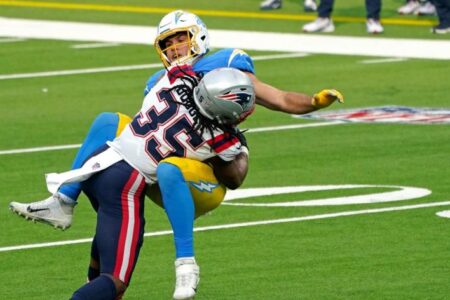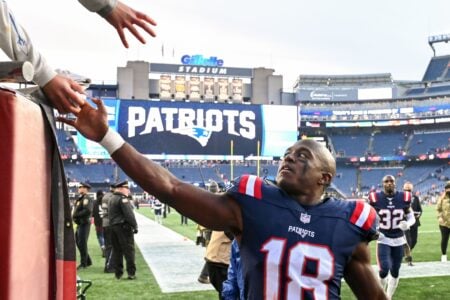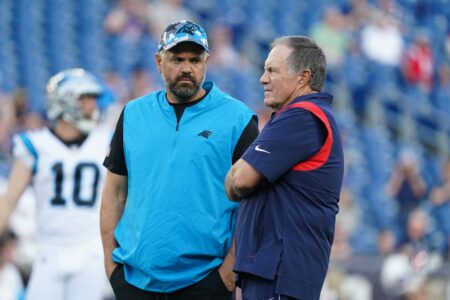I've been thinking about the two-point conversion for a while and what it means for the NFL and game strategy. Peter King wrote about it in his most recent MMQB piece, so I thought it might be worth discussing here.
Here's an article that uses stats from 2000-2009 (Advanced NFL Stats: Almost Always Go for 2-Point Conversions?), so we're missing several years' worth of data. I will work on the assumption that not too much has changed, so the numbers are still fairly relevant.
Here are some interesting tidbits:
"There have been 718 2-point conversion attempts from 2000-2009, including playoff games. Overall, they've been successful 46.3% of the time. But this is slightly misleading because it includes aborted kick attempts. If we weed those out, along with some other mysterious plays, such as Josh McCown's kneel-down while trailing by 5 points in the final few seconds of the Cardinals-Vikings 2003 game, we get a different answer. For all normal 2-point conversions, the success rate is 47.9%."
Ok, so we start with a normal success rate of 47.9%. However, that can be broken down further into rushing vs. passing plays.
2-point passes: 43.4% success (525 attempts)
2-point rushes: 61.7% success (183 attempts)
TOTAL: 339-708 (47.9%)
If you weed out the QB scrambles/runs and just go with conventional running plays, you get this:
2-point passes: 43.4% success (525 attempts)
2-point QB runs: 74.5% success (47 attempts)
2-point RB runs: 57.4% success (136 attempts)
TOTAL: 339-708 (47.9%)
Now, what's clear from these numbers is that teams going for 2-point conversions throw FAR more than they run, and yet running is FAR more successful. So it is a mystery why they throw as much as they do. Other than that the league has become so pass-heavy it's almost their default position.
Looking at New England's data from 2012 (2012 Patriots Defensive Stats, Breaking Down The Patriots Performances on 1st Down, 2nd Down, 3rd Down,4th Down and Total Number of Plays - thanks Ian!), we can see how the Patriots do on either 3rd and 2 or 4th and 2 situations (I want to limit it to those because 2nd and 2 is COMPLETELY different than, say, 4th and 2. 3rd or 4th and 2 is a far better comp to a 2-point conversion). Here were the Patriots' numbers in 2012 on 3rd and 2 or 4th and 2:
3rd and 2: 26 plays, 14 conversions (53.8%)
4th and 2: 1 play, 1 conversion (100.0%)
TOTAL: 27 plays, 15 conversions (55.6%)
So 55.6% of the time, the Patriots converted from 2 yards out. Since 2001, here are the Pats' 2-point conversion numbers:
2-point passes: 7-17 (41.1%)
2-point rushes: 9-12 (75.0%)
TOTAL: 16-29 (55.2%)
These numbers line up very well with the NFL in general.
So let's put this together. The league as a whole converts less than 50% of their 2-point conversions. But the Patriots convert 55.2% of theirs, and 55.6% of their 3rd/4th and 2 plays. The Pats scored 67 touchdowns in 2012. Gostkowski has made 355 out of 356 career PATs, so let's just call him 100% at PATs. That means that the Patriots would have scored 67 points after touchdowns in 2012.
But at a 55% conversion rate, over 67 touchdowns, they would have converted 37 2-point conversions. 37 x 2 = 74.
Therefore, the Patriots would have gained an additional seven points over the course of a season by going for 2. If they ran it more, they'd convert even more, based on their past success rate.
So the question here is this: Why don't the Patriots go for 2 every time? It doesn't make sense to go for two regularly if your success rate is less than 50%. But for the Patriots, it's greater than 50%. So it makes sense for them to go for it every time. Of course there will be failures. But they will succeed more often than they will fail, and that will be a net positive.
Now I know Belichick knows these numbers and he obviously knows football far more than I do or pretty much anyone else for that matter. But the math here doesn't lie. Why do you think they don't go for 2 regularly? I know it's not orthodox, but that's never seemed to bother Belichick before.
Here's an article that uses stats from 2000-2009 (Advanced NFL Stats: Almost Always Go for 2-Point Conversions?), so we're missing several years' worth of data. I will work on the assumption that not too much has changed, so the numbers are still fairly relevant.
Here are some interesting tidbits:
"There have been 718 2-point conversion attempts from 2000-2009, including playoff games. Overall, they've been successful 46.3% of the time. But this is slightly misleading because it includes aborted kick attempts. If we weed those out, along with some other mysterious plays, such as Josh McCown's kneel-down while trailing by 5 points in the final few seconds of the Cardinals-Vikings 2003 game, we get a different answer. For all normal 2-point conversions, the success rate is 47.9%."
Ok, so we start with a normal success rate of 47.9%. However, that can be broken down further into rushing vs. passing plays.
2-point passes: 43.4% success (525 attempts)
2-point rushes: 61.7% success (183 attempts)
TOTAL: 339-708 (47.9%)
If you weed out the QB scrambles/runs and just go with conventional running plays, you get this:
2-point passes: 43.4% success (525 attempts)
2-point QB runs: 74.5% success (47 attempts)
2-point RB runs: 57.4% success (136 attempts)
TOTAL: 339-708 (47.9%)
Now, what's clear from these numbers is that teams going for 2-point conversions throw FAR more than they run, and yet running is FAR more successful. So it is a mystery why they throw as much as they do. Other than that the league has become so pass-heavy it's almost their default position.
Looking at New England's data from 2012 (2012 Patriots Defensive Stats, Breaking Down The Patriots Performances on 1st Down, 2nd Down, 3rd Down,4th Down and Total Number of Plays - thanks Ian!), we can see how the Patriots do on either 3rd and 2 or 4th and 2 situations (I want to limit it to those because 2nd and 2 is COMPLETELY different than, say, 4th and 2. 3rd or 4th and 2 is a far better comp to a 2-point conversion). Here were the Patriots' numbers in 2012 on 3rd and 2 or 4th and 2:
3rd and 2: 26 plays, 14 conversions (53.8%)
4th and 2: 1 play, 1 conversion (100.0%)
TOTAL: 27 plays, 15 conversions (55.6%)
So 55.6% of the time, the Patriots converted from 2 yards out. Since 2001, here are the Pats' 2-point conversion numbers:
2-point passes: 7-17 (41.1%)
2-point rushes: 9-12 (75.0%)
TOTAL: 16-29 (55.2%)
These numbers line up very well with the NFL in general.
So let's put this together. The league as a whole converts less than 50% of their 2-point conversions. But the Patriots convert 55.2% of theirs, and 55.6% of their 3rd/4th and 2 plays. The Pats scored 67 touchdowns in 2012. Gostkowski has made 355 out of 356 career PATs, so let's just call him 100% at PATs. That means that the Patriots would have scored 67 points after touchdowns in 2012.
But at a 55% conversion rate, over 67 touchdowns, they would have converted 37 2-point conversions. 37 x 2 = 74.
Therefore, the Patriots would have gained an additional seven points over the course of a season by going for 2. If they ran it more, they'd convert even more, based on their past success rate.
So the question here is this: Why don't the Patriots go for 2 every time? It doesn't make sense to go for two regularly if your success rate is less than 50%. But for the Patriots, it's greater than 50%. So it makes sense for them to go for it every time. Of course there will be failures. But they will succeed more often than they will fail, and that will be a net positive.
Now I know Belichick knows these numbers and he obviously knows football far more than I do or pretty much anyone else for that matter. But the math here doesn't lie. Why do you think they don't go for 2 regularly? I know it's not orthodox, but that's never seemed to bother Belichick before.


















